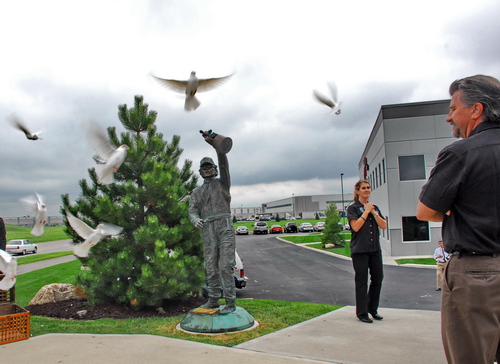ERIC MEDLEN PROJECT SAVING LIVES
 The Eric Medlen Project Saving Lives Going Forward …
The Eric Medlen Project Saving Lives Going Forward …

The memory of the loss still haunts the drag racing community.
March 23 will mark the second year since the tragic accident that killed Funny Car driver Eric Medlen.
As painful as the loss has been, many will gain solace in knowing that Medlen’s death has led to the creation of a safer and better engineered Funny Car. While there are no accomplishments that will ease the burden of the loss, knowing that the chances of a similar loss of life are greatly reduced, helps many to cope.
The racing community can thank the Eric Medlen Project for that assurance.
In the aftermath of that accident, John Force Racing and Ford Racing banded together to form The Eric Medlen Project, with an eye on finding and improving safety innovations for the sport. Along with the NHRA, John Force Racing and Ford Racing have instituted a series of safety measures ranging from significant Funny Car chassis modifications to the instillation of the Ford Blue Box (crash data recorder) on all nitro cars.
The Eric Medlen Project is based in Indianapolis and housed within a special 50,000 square foot building.
“You can see everything that we have developed working with NHRA, working with Ford Motor Company and their technicians,” explained team owner John Force. “You can go there because we built a virtual reality tour and you can walk through and see it, what we’ve done.”
Force offers documentation from Ford as proof positive the Eric Medlen Project is making a difference.
“When we do our car shows that’s where we are going to educate the people, to show them what we created from the crash of Eric, the loss of Eric, something has to come out of that, and it has, a better and safer race car and it will still run for the title,” Force added.
“Last year was the Blue Box implementation for all nitro cars, as well as the new chassis design,” Dimarco explained. “This year, we’re also moving forward with some of our production car technology and personnel. We’re modeling the occupant within the computer to simulate accidents similar to Eric’s, as well as a crash similar to Scott Kalitta’s. We can evaluate anything that the body can touch, as well as any vibrations that are put into the body, on the computer, as well as a physical test, that’s being replicated as well.”
Medlen’s crash, as well as the one suffered by Force in 2007, has enabled additional innovations to be implemented.
“Maybe not so much in the chassis itself, but innovations in the padding, the helmets, the surrounding areas and what the driver can physically touch,” Dimarco explained. “That is where we will be looking at for improvements. It’s things like that where the occupant model will help us evaluate.”
After Medlen’s accident the first area that Dimarco and the Ford team studied was the area surrounding the driver’s head. This was the source of Medlen’s injuries and the data gleaned from the accident influenced them to widen the surround and begin simply with adding more padding. This move helped reduce some of the loads on the driver’s head.
Dimarco believes those changes were instrumental in saving John Force’s life in his crash at Dallas.
The next step, according to Dimarco, was to look at the chassis and why it broke, and he confirmed that Force’s chassis broke in the same places that Medlen’s chassis broke.
“That allowed us to focus on looking at those hot spots and how to remove them from the chassis,” Dimarco added. “Or, in the case that we have now, they’re completely out of the chassis for a torsional event that was seen in Eric and John’s accidents. In order to do all that, we needed data, and the Blue Box data that is running in all of the Nitro cars now was very instrumental in gathering data for all the chassis that have cracked on the track. The data collected from the boxes also helped us reproduce the accident from Scott Kalitta last year.”
Dimarco sees various production car technologies that can be applied to the Funny Car designs going forward.
“Although nothing is finalized, there could be things like automatic shut offs, seat belt pretensioners, air bags around the head … just about anything that’s already in the production car,” Dimarco added. “We are working closely with the Ford safety office to see what we can physically put in the car, as well as what’s feasible from a racer’s standpoint with the NHRA.”
Can this research eventually make its way to production cars?
“We’re pushing the limits on the models that we’re using from the standpoint of the head and the brain models,” Dimarco explained. “Production cars don’t usually look at vibration as significantly as we’re seeing in the Funny Cars, so they’re evaluating their models using our data to improve our production car safety as well. That’s important for the racers, as well as for our consumers.”




































